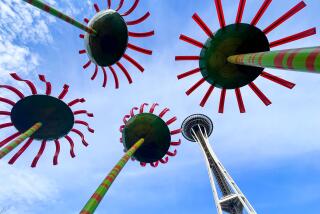No Love Lost for Kingdome
SEATTLE — It leaked. Acoustic tiles fell from the ceiling. For years, it seemed empty every night.
When the Seattle Mariners leave the Kingdome for good after today’s game against Texas, it won’t exactly be like Detroit’s departure from Tiger Stadium in September.
“I’ve never cared for it from the first day,” Mariners general manager Woody Woodward said.
Built for $67 million in 1976, many consider the Kingdome a blight on Seattle’s skyline--the antithesis of the futuristic Space Needle, the city’s symbol since the 1962 World’s Fair.
In the 1990s, when the Mariners started to win, fans turned out to watch Ken Griffey Jr., Alex Rodriguez and Randy Johnson. And by doing that, they condemned the Kingdome to destruction.
On July 15, the Mariners leave the gray, mushroom-shaped, multipurpose stadium for Safeco Field, a $517 million ballpark with a retractable roof.
After the Seattle Seahawks finish their 1999 NFL season, the Kingdome will be torn down to make way for a new $430 million football stadium, scheduled to open in 2002.
“We’ve had success here,” Mariners manager Lou Piniella said, “but we can have just as much success or more at the new ballpark.”
The new ballpark will have everything the Kingdome didn’t--grass, blue sky and, on some days, sunshine.
Players consider the Kingdome a dump. Former Mariners center fielder Dave Henderson, now a team broadcaster, says its artificial turf field took a toll.
“You can play five or six years on turf and five or six years on grass and there’s no comparison at all,” he said. “The turf and the concrete seems like 10 years. The grass seems like five years.”
The Kingdome, one of five major league ballparks closing this year, is the newest by far. Tiger Stadium opened in 1912, Milwaukee’s County Stadium in 1953, San Francisco’s former Candlestick Park in 1960 and Houston’s Astrodome in 1965.
The first major league game in the Kingdome was April 6, 1977--Nolan Ryan’s 27-year career was five-years longer than the Kingdome’s.
“I’m not going to feel sad leaving this place,” said Dave Niehaus, a Mariners announcer since the team’s first season. “But it’ll be an emotional game on the 27th of June.”
Until 1991, it appeared the Mariners deserved the drab and dreary Kingdome. They had 14 consecutive losing seasons until Jim Lefebvre’s 1991 team went 83-79.
After the first season, when box seats cost $5, the Mariners failed to reach 1 million in attendance for four straight years, drawing a franchise-low 636,276 in 1981. The 1978, 1980 and 1983 teams each lost more than 100 games.
It’s been different in the 1990s. The Mariners drew 2.7 million in 1996 and 3.2 million in 1997, when they won their second AL West title.
“I think when you judge the true value of a baseball stadium, it starts with the fans,” said manager Lou Piniella, who took over after the 1992 season. “Certainly, there’s no comparison between Safeco Field and the Kingdome.”
Still, without the Kingdome baseball wouldn’t have come back to Seattle.
When the Seattle Pilots moved to Milwaukee after one season on April Fool’s Day 1970, Slade Gorton, then Washington state’s attorney general, sued the American League. Rather than fight the lawsuit, the AL awarded Seattle an expansion franchise.
From the beginning, the Kingdome was inadequate. After Southern California businessman George Argyros bought the Mariners in January 1981, he threatened to move unless King County granted major lease concessions, which it gave.
Jeff Smulyan bought the Mariners in October 1989 and almost from the start said baseball couldn’t pay for itself in the Kingdome. After rumors he would try to move the franchise to Tampa, Fla., he sold the team in July 1992 to a group headed by headed by Nintendo president Hiroshi Yamauchi, who has never been to the United States or seen a major league game.
Finally, in October 1995, funding for Safeco Field was approved by the Washington Legislature. The final bill will be about $100 million over the $417 million budget, and the Mariners and the government are fighting over the tab.
By the time the final pitch is thrown Sunday, the Kingdome will have lasted 22 1/2 seasons and 1,755 games. But it will last for at least two decades in taxpayers’ checkbooks.
On July 19, 1994, four wood-fiber acoustical tiles, each weighing about 20 pounds, crashed into the stands hours before the Mariners were supposed to play Baltimore.
While there weren’t injuries, the Kingdome was closed for four months for repairs, and the Mariners finished the year with a 22-day road trip. (The Seahawks played some of their “home” games at the University of Washington’s Husky Stadium).
The repair bill came to $70 million--part of the $127 million still owed on the Kingdome. The debt, financed by a 2 percent hotel and motel tax, isn’t scheduled to be entirely repaid until 2016.
By that time, the Mariners hope to have won several championships, using the new revenue from their new ballpark. The top ticket price goes up from $28 to $33.
“I think that people who are going to put the ballclub together will have more to work with now than we have in the past,” Woodward said. “We’ll still be in a small market and we won’t be the Yankees, but we’ll be able to attract players to this facility. We’ll be able to have more resources. I think there’s nothing but good things ahead.”
More to Read
Go beyond the scoreboard
Get the latest on L.A.'s teams in the daily Sports Report newsletter.
You may occasionally receive promotional content from the Los Angeles Times.










